Sunscreen sticks are really convenient, but it’s difficult to measure out how much you need to apply, or whether you’ve applied enough. So I decided to put them to the test!
I recently did a few investigations of sunscreen sticks. I tried to work out:
- How much protection you’re getting with reasonable amounts of sunscreen sticks
- How much you would need to apply to get the full labelled SPF
- How many passes of a sunscreen stick gives full protection
- What spots got missed with sticks
The results were really interesting, and I learned a lot I wasn’t expecting!
The video version is here, keep scrolling for the more detailed write-up of the experiments…
Sunscreen Stick Face Test
The first test I did was to estimate how much protection I was getting with a normal, generous application of sunscreen stick, and how that compared with the amount needed for the labelled SPF.
SPF tests are done by weight, so I used scales to weigh how much I applied.
From a previous measurement, I knew my face needed 0.76 g to achieve the labelled SPF (2 mg/cm² coverage). I used this to work out the estimated SPF I was achieving with each layer (assuming a linear relationship between amount applied and SPF).
I also calculated how much time I spent with each sunscreen stick on my face. Everyone has a different idea of what a “generous application” is, so application time could serve as a better reference point for people who don’t own scales.
I used three Korean SPF 50+ sunscreen sticks for this test:
- Tocobo Cotton Soft Sun Stick: actives = octocrylene, octinoxate, octisalate, DHHB, BEMT
- Abib Quick Sunstick Protection Bar: actives = octinoxate, octisalate, DHHB, BEMT, octocrylene
- Benton Mineral Sun Stick: active = titanium dioxide
Amount applied, SPF and application time
Procedure
I weighed a stick, applied what I thought was a generous layer while looking at myself (I was filming with my phone in selfie mode), then reweighed the stick.
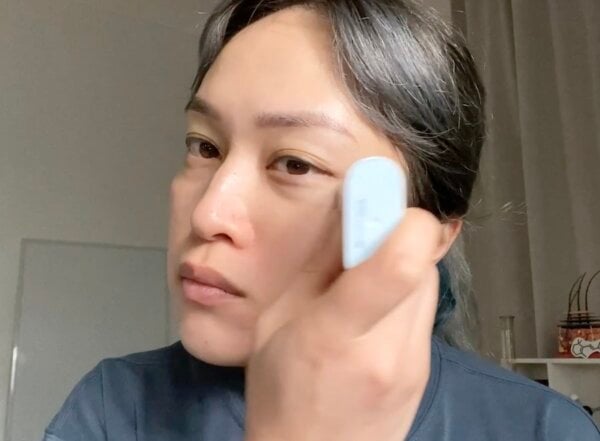
Because it turned out I applied a lot less than I assumed I would, I did this twice more with each stick before moving onto the next. I still didn’t get to the full application amount with any of the sticks, but I stopped when I felt like my face was applying more sunscreen back to the stick (it was a greasy impractical mess by this point anyway).
Amount applied: I weighed each stick at the start, and after each round of generous application (“Layer”)
Estimated SPF: I calculated this based on 0.76 g being a full application for my face, and assuming a linear relationship between amount applied and SPF, for an SPF 50 stick (SPF = mass applied ÷ 0.76 × 50)
Time on face (seconds): I painstakingly cut out the parts of the footage where the sunscreen stick left my skin, and added the times together. The times shown were abut 20-25% shorter than the total application time (including the gaps when the stick left my skin).
The detailed procedures are at the bottom of this post.
Results
Here are the results (you can also open up the full results table here):
| Layer | Accrued mass (g) | SPF equivalent | Accrued time on skin (sec) | Layer mass (g) |
|---|---|---|---|---|
| Tocobo 1st | 0.29 | 19.1 | 43.0 | 0.29 |
| Tocobo 2nd | 0.49 | 32.2 | 87.5 | 0.20 |
| Tocobo 3rd | 0.69 | 45.4 | 152.5 | 0.20 |
| Abib 1st | 0.25 | 16.4 | 44.0 | 0.25 |
| Abib 2nd | 0.43 | 28.3 | 111.5 | 0.18 |
| Abib 3rd | 0.59 | 38.8 | 188.0 | 0.16 |
| Benton 1st | 0.33 | 21.7 | 78.5 | 0.33 |
| Benton 2nd | 0.51 | 33.6 | 160.5 | 0.18 |
| Benton 3rd | 0.63 | 41.4 | 220.0 | 0.12 |
On average:
- 1 generous application weighed 0.29 g (around SPF 19.1) after 55.2 seconds on the face
- 2 generous applications weighed 0.48 g (around SPF 31.4) after 119.8 seconds on the face
- 3 generous applications weighed 0.64 g (around SPF 41.9) after 186.8 seconds on the face
I was really surprised by these results – I previously assumed I applied at least half the required amount in the first layer!
Even for just the first layer, I applied the sticks for longer and more thoroughly than I normally would to get a best case scenario result. Despite this, the first layer only achieved a bit over 1/3 of the required application amount on average, and each stick had been touching my face for over 43 seconds (about 50 seconds total time).
In contrast, it takes me about 60 seconds to apply a full 0.76 g of my usual lightweight lotion sunscreens. After 3 layers of stick sunscreen, I had applied a smaller amount (average 0.64 g), despite spending almost 4 times as long applying the product!
Comparison between sticks
While this test wasn’t really designed to be a fair test to compare the three sticks, there are some interesting trends.
The total amount applied was the highest for Tocobo, then Benton, then Abib – despite spending the longest time applying the Abib stick.
The first layer of the Benton stick was the thickest out of the three sticks, but the subsequent layers dropped a lot faster. For all three sunscreens, there was less applied for each additional layer despite applying for a longer time on average.
I think these trends are due to the textures of the sunscreens:
- For the first layer, the Benton stick was the grippiest on my skin and even felt like it was tugging my skin around a bit. It took longer for me to feel like I’d applied a layer thoroughly, hence the longer (almost double!) application time compared to the other two sticks. I wasn’t aware of this discrepancy until reviewing the footage – it really didn’t feel like I applied an even layer of sunscreen until I stopped! But for later layers, it didn’t feel like the Benton stick gripped onto the previous layers very well. (It was also the last sunscreen I tested so I might’ve been influenced by the results of the other two sticks, but subjectively I wasn’t aware I spent that much longer, plus there was no noticeable increase between Tocobo and Abib trials.)
- The Abib stick felt the smoothest going on, but the lack of friction meant less product was leaving the stick – very pleasant to use, but not ideal for sun protection.
- The Tocobo stick struck a good balance between glide and friction, and subsequent layers still applied reasonably well.
Number of passes?
The American Academy of Dermatology recommends applying 4 passes of a sunscreen stick for sufficient coverage. It isn’t clear how they arrived at this number, and there’s been a lot of speculation about its accuracy, so I decided to test this out.
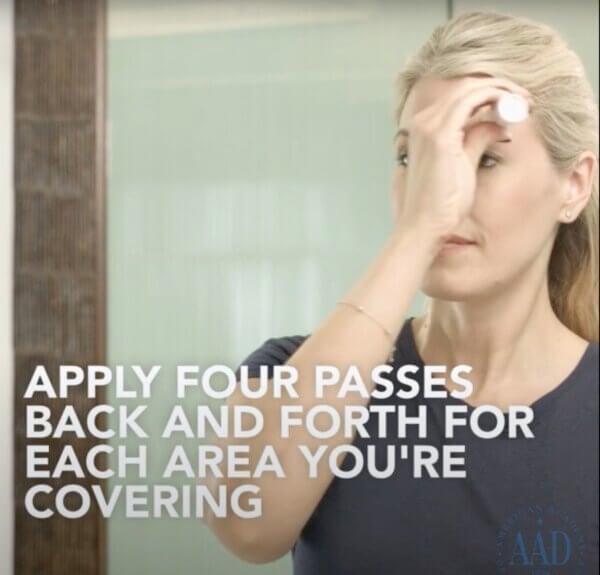
Passes on the face
I counted how many passes I did with the sticks in the footage, on 4 different spots on my face, then averaged them out.
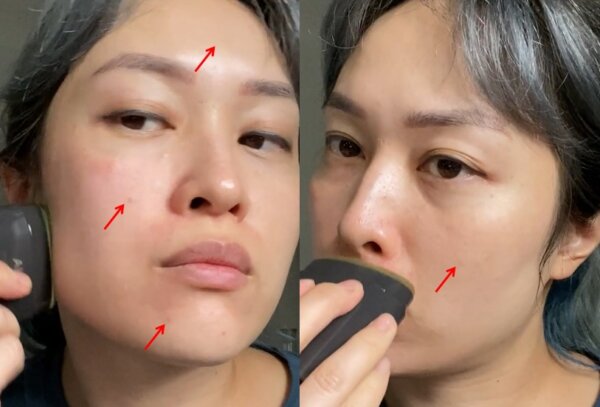
This was way more ambiguous and time-consuming than it sounds (see detailed procedure at the bottom), so these should be treated as very ballpark numbers. But I think it reflects how consumers would be moving a stick across their irregular face surfaces. (Full results table here.)
| Layer | L cheek passes | R cheek passes | Forehead passes | Chin passes |
|---|---|---|---|---|
| Tocobo 1st | 8 | 8 | 8 | 7 |
| Tocobo 2nd | 9 | 9 | 11 | 9 |
| Tocobo 3rd | 13 | 8 | 11 | 12 |
| Abib 1st | 11 | 6 | 9 | 7 |
| Abib 2nd | 11 | 8 | 14 | 15 |
| Abib 3rd | 24 | 14 | 15 | 15 |
| Benton 1st | 9 | 6 | 16 | 12 |
| Benton 2nd | 11 | 13 | 17 | 20 |
| Benton 3rd | 9 | 7 | 9 | 17 |
On average:
- 8.9 passes after 1 layer (0.29 g, SPF ~19.1, 55.2 seconds)
- 21.2 passes after 2 layers (0.48 g, SPF ~31.4, 119.8 seconds)
- 34.0 passes after 3 layers (0.64 g, SPF ~41.9, 186.8 seconds)
It was interesting to see the consistent bias I had for the side of my face that was closer to the camera! I think if I had picked different spots I could end up with quite different counts.
But I think it’s pretty clear that:
- 4 passes probably isn’t sufficient
- Number of passes in general just doesn’t seem to be a good guideline
(In the AAD sunscreen stick demonstration video, the 4 passes don’t actually overlap, even though the model (not sure if she’s a dermatologist?) is staring at herself in the mirror. I would assume she was instructed to demonstrate 4 passes – further evidence that it isn’t a good guideline!)
Passes on the arm
Since I wasn’t confident about my counting, I also did a test on the flat surface of my arm. The skin there is flat and a bit furry, so one pass should transfer a lot more sunscreen (flat = full stick contact the whole time, furry = grabs onto more sunscreen). This could be considered a best case scenario situation.
I weighed the amount applied with 20 passes of the Tocobo stick straight up or down my arm (4 passes didn’t transfer enough sunscreen to be reliably weighed with my scales).
Then I measured the application area as best I could with a UV camera, marker and ruler.
I repeated this a few times, then with the Abib stick too (the Benton stick didn’t show up well on the UV camera).
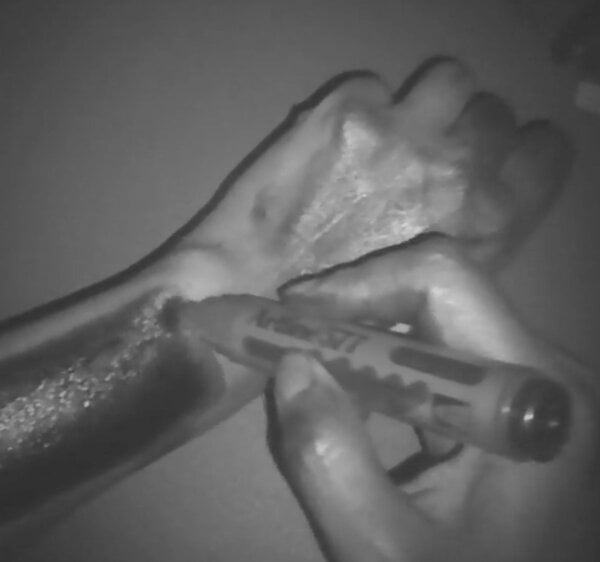
For the first run with the Tocobo stick, I pressed much harder than I would on my face and there was a lot of sunscreen caught on my hair – I think that’s why the coverage was so much higher compared to the face measurements. For later runs I used lighter pressure.
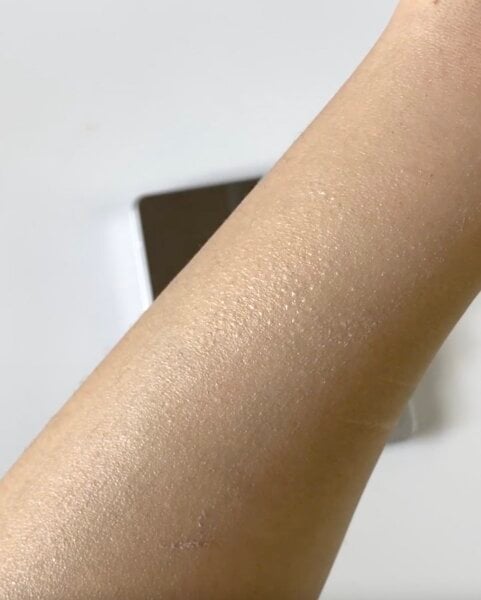
For the Abib stick, I was curious how many swipes I needed to get the full amount but gave up after 60. The second run with the Abib stick was done using firm pressure.
| Trial | Passes | Area (cm²) | Mass | mg/cm² |
|---|---|---|---|---|
| Tocobo 1 (firm) | 20 | 56 | 0.14 | 2.5 |
| Tocobo 2 | 0 | 52.5 | 0.10 | 1.9 |
| Tocobo 3 | 20 | 48 | 0.11 | 2.3 |
| Abib 1 | 20 | 64 | 0.06 | 0.94 |
| Abib 1 (cont) | 40 | 64 | 0.10 | 1.6 |
| Abib 1 (cont) | 60 | 64 | 0.12 | 1.9 |
| Abib 2 | 20 | 68 | 0.10 | 1.5 |
Based on these numbers, I would need ~16-21 passes of the Tocobo stick or ~40-64 passes of the Abib stick to achieve 2 mg/cm² coverage. For the Abib stick, you could see the same issue as in the face trial – it’s so slick that not much sunscreen transfers from the stick to the skin after a while.
The amount applied seemed to be highly dependent on pressure, so I don’t think the specific number of passes from this arm test is all that useful for guiding real life application.
But I think we can safely conclude:
- My face counts are a reasonable estimate. The amount applied with 20 passes on the face vs arms differed by 20-35% – this could be explained by pressure difference and how much stick is actually touching the skin.
- The “4 passes” recommendation is a massive underestimate (except perhaps for an unusually soft stick applied with extremely firm pressure)
It’s possible that this “4 passes” recommendation came from UV camera footage – I noticed that the darkness of the applied patch didn’t change much after 4 passes:
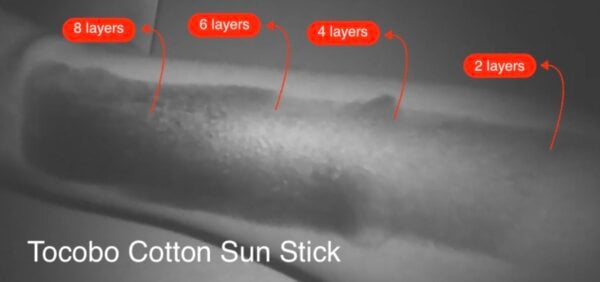
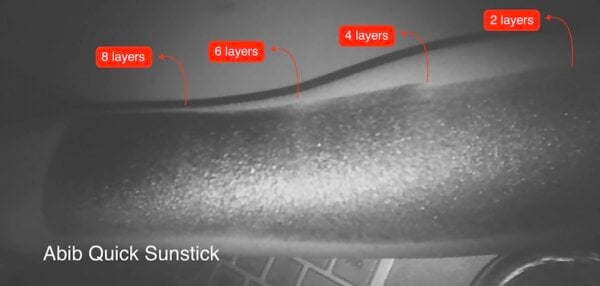
This really highlights how UV cameras are a very poor method for estimating SPF.
Missed spots
UV cameras are very useful for seeing missed spots though! I checked what the coverage was like after the first layer for the chemical sunscreens using the UV camera (you can’t see the mineral sunscreen clearly).
Even though I was applying the sticks while staring at myself, I missed a bunch of spots I’ve never missed before.
I missed the middle of my nose both times, even though I was mindful that nose coverage was a problem when I doing the second Abib run! (The video footage is a lot clearer than these frames.)
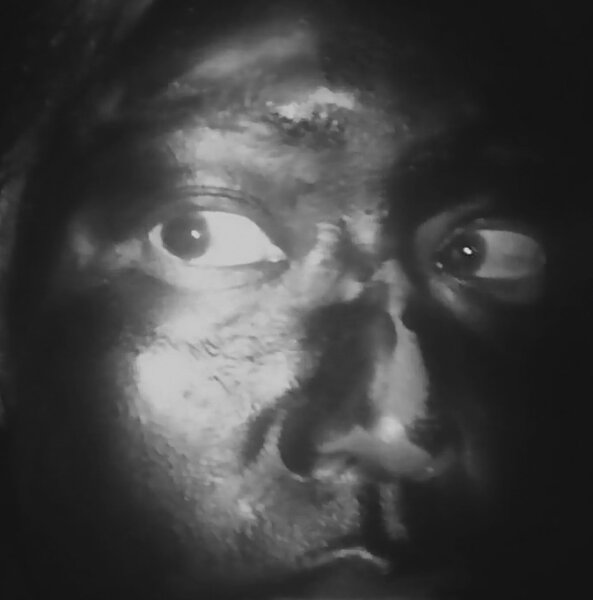
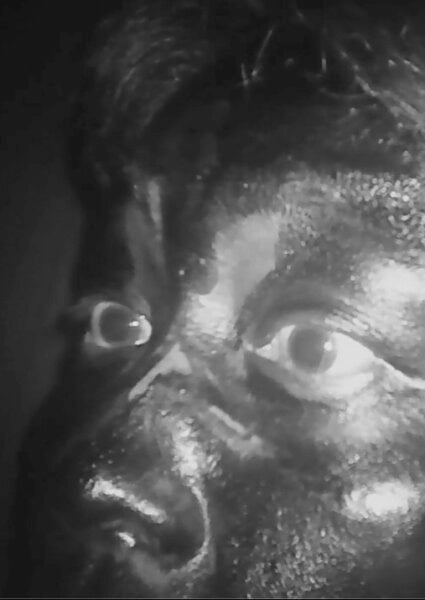
I also missed some spots I miss quite often, like my eyebrows, under my browbone, near my hairline and next to my nostrils (the nose… crevice?).
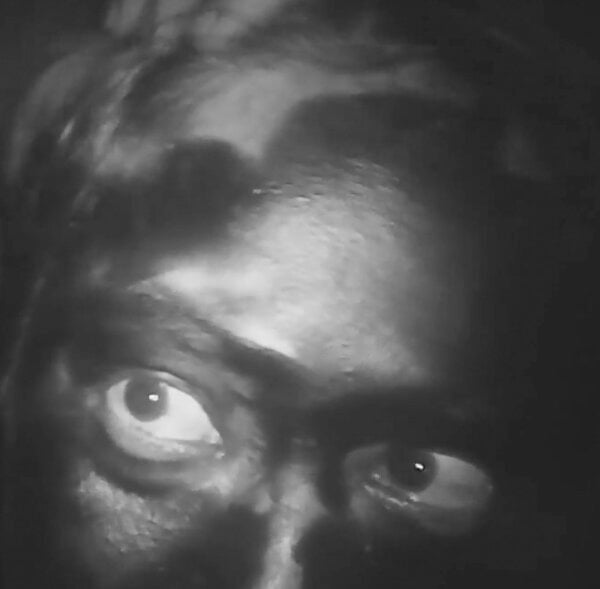
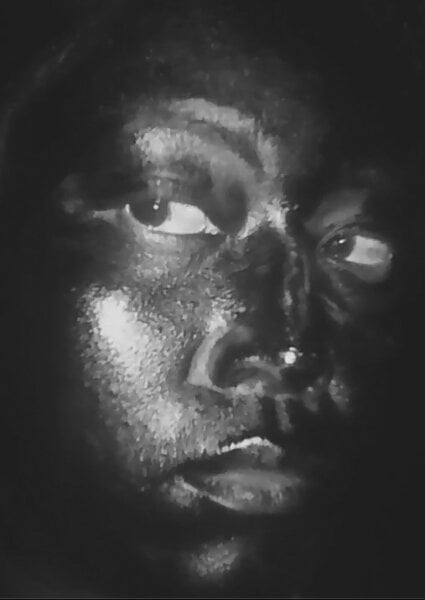
Sticks aren’t as ergonomic as your fingers when going into awkward spots or over hard ridges, and you don’t get as much feedback when you’re applying. I can apply a lotion on my face without looking and only miss a couple of spots.
While this issue was easy to fix (you just have to rub the sunscreen stick in), you do lose a bit of the convenience. And if you don’t have a UV camera, you can’t see which bits need rubbing, so you’d just have to rub all over.
Texture
For these sunscreen sticks, that first layer (~0.29 g) already felt thicker and more substantial than a full 0.76 g of lotion sunscreen.
I think this is because of their formulas. Sunscreen lotions are usually at least 50% water, and can also have volatile solvents like alcohol and cyclopentasiloxane. After applying the right amount, the sunscreen dries down and these evaporate off your skin.
There aren’t many volatile ingredients in sticks, so everything you apply stays on your skin and you end up with a much thicker layer at the end than with a lotion. The texture is also thicker, so the oils don’t sink in much and you can feel it a lot more.
All three sticks still felt quite nice on my skin after Layer 1.
After Layer 2, the textures were still acceptable but starting to get slidey – I don’t think make-up would stay put too well over it (they might be less slick on dry skin).
After Layer 3, all the sticks were a slippery mess, and white grease came off on my fingernails when I touched my Benton-covered face.
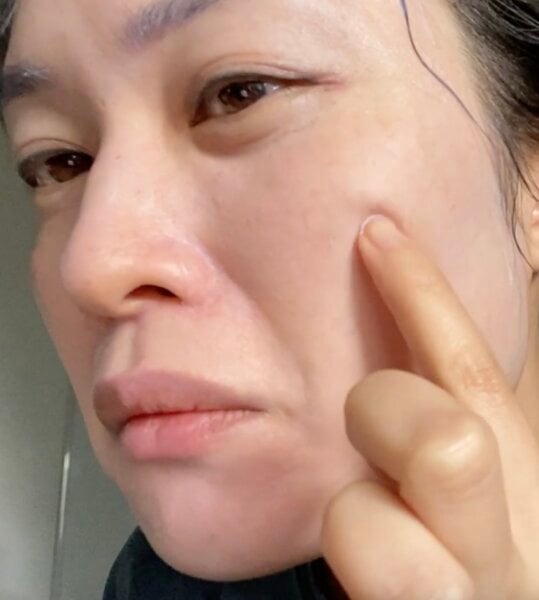
Appearance
Unsurprisingly, neither the Tocobo or Abib sticks left any white cast, since they use organic sunscreen filters only.
The Tocobo stick looked quite matte and silky after Layer 1, but were dewy (but not glossy!) with Layers 2 and 3.
The Abib stick looked dewy after Layer 1, then quite glossy after 2 and 3.
The Benton stick had only a little white cast after Layer 1, but was fairly whitening after Layer 2 and pretty ghastly after Layer 3.
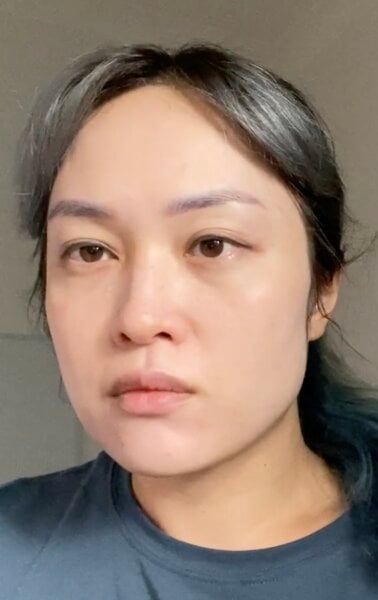
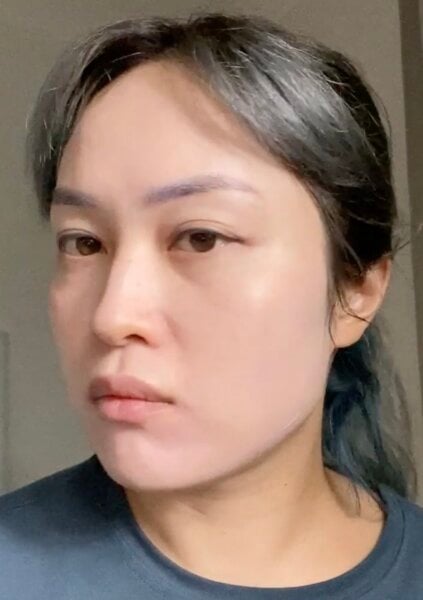

Practical implications
Based on these observations, I really don’t think a sunscreen stick is a good choice as your main form of sun protection, if you’re getting a lot of sun exposure.
A full application of a sunscreen stick is far more than expected, feels heavy and slippery, and takes far longer to apply than a sunscreen lotion – even with these relatively lightweight Korean sunscreen sticks. It’s also easier to miss spots. Sticks also tend to cost more.
However, sticks could be useful in limited situations:
- As a light top-up, especially over make-up
- To avoid getting sunscreen on your hands
- To avoid eye sting (can use the stick around the eyes only)
- When other options aren’t practical (e.g. wriggly or fussy kids)
Obviously these experiments have a lot of limitations – in particular, the fact I was the only person who did them and saw the results as I was collecting them. I’d love to see other people’s results!
Detailed procedures
Weight applied
1. Wash face thoroughly and allow skin to dry
2. Tare scales with sunscreen stick (scales are consistently accurate to <±0.02 g, calibrated with water and gastight syringes).
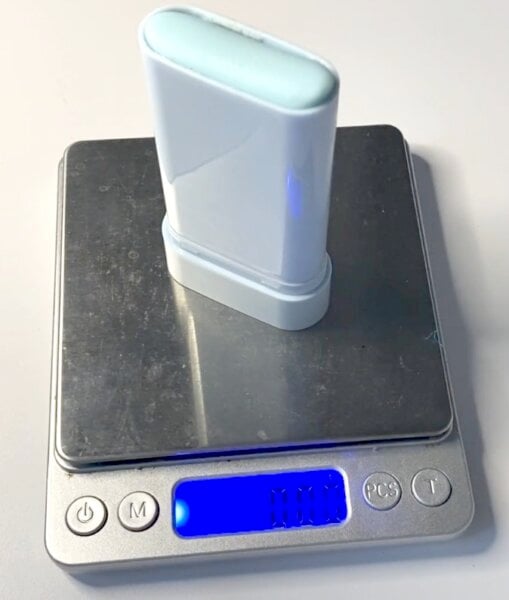
3. Apply generous amount of sunscreen stick on face while filming on phone in selfie mode (so I could see where I was applying) = Layer 1

4. Reweigh stick
5. Apply second generous amount of sunscreen stick on face, then reweigh stick = Layer 2
6. Apply third generous amount of sunscreen stick on face, then reweigh stick = Layer 3
7. Repeat all steps with other two sticks
(Steps 5 and 6 were added when I saw the result of the each layer – I stopped at 3 layers because it felt like my skin was applying the sunscreen back to the stick by that point.)
I didn’t notice the time I’d spent applying the sticks on my phone, so “generous” was purely subjective – the time spent with the stick on my face is a better point of reference for generalisation.
Time applied
1. Convert footage to constant frame rate (30 fps)
2. Use video editing software (I used Final Cut Pro) to cut out parts where the sunscreen stick lifted off skin for more than 10 frames (0.33 seconds). There were a lot of judgement calls since there was only one camera angle – I judged based on whether the skin was stretching and how fast the stick was moving.
3. Delete all gaps and record the total time calculated by the software. I rounded to the nearest half-second since the precision isn’t that great.
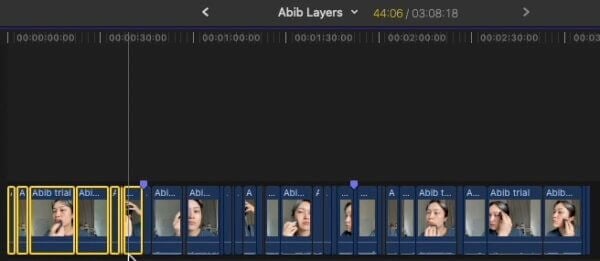
The total application time (including the gaps when the stick left my skin) was about 20-25% longer than these times shown.
Face Passes
In video editing software, go through condensed version (from above) and count how many times the stick passed over 4 spots on the face:

- I found this easiest to do with visible marks on the face – I had spots everywhere except in the middle of my forehead (I wanted this because it’s the flattest part of my face)
- It was pretty difficult to judge whether the stick was actually touching each spot when it passed over on the camera. The stick is hard, most parts of the face are round – when the end of the stick passes over a spot, it could be slightly lifted off the skin. I’m not sure how this could be quantified accurately without an intense number of cameras at different angles, or a pressure sensor – but then it wouldn’t translate that well to real life advice either. So I just counted a pass when it looked like the stick went over the spot, and decided to do the arm pass test as a reality check for the face counts.
Arm Passes
1. Wash left arm thoroughly and allow skin to dry.
2. Tare scales with sunscreen stick
3. Apply 20 passes up and down upper forearm, trying to stay in the same region as much as possible for each pass
4. Using a UV camera, mark out the area covered with a marker (I found that the shiny patch was pretty much the same as the dark area under the UV camera, so this can be done without a UV camera too if you only have scales!)
5. Measure the dimensions with a ruler, with arm held at the same angle as during application (the skin surface area changes when you bend your arm or if you twist it)
6. Calculate area as a trapezoid (my areas were approximately trapezoidal, with the short sides being virtually the same, but the long side was 1 cm off for some runs)
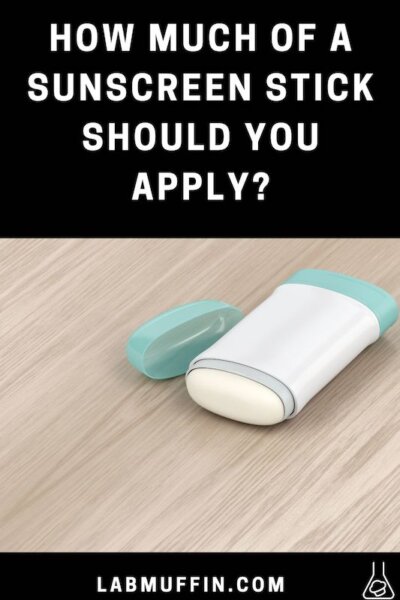
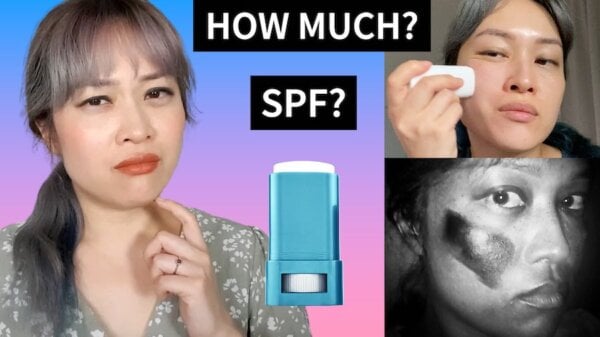


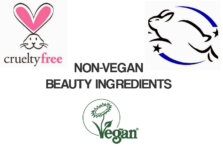
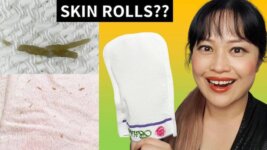

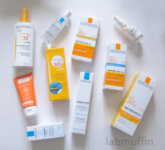
I always thought that the ingredients have a higher concentration in sticks and that therefore you don’t need to apply as much as you would need from a lotion
If the stick’s SPF rating was higher than the lotion’s that would be the case, but all SPF testing is done with the same mass of product per area (2 mg/cm2), including for powders, sprays and sticks.
Interesting. Thank you so much. I’m a long time fan 😊
I love how much dedication you put into every article.
I loved sticks but it always seemed dubious that “a few swipes” would do the trick. Thanks for doing this experiment!
American here – I have a zinc stick that leaves virtually no white cast when I apply. Your post has now made me realize why that is lol thank you
I love your content and have been reading your posts for years. Over the last year or so, I finally started watching your videos, and now it is impossible for me to read your posts without hearing your voice in my head! 😂
That’s too bad because I used to love using a sunscreen stick on my hair part — it was easy to apply and made my hair less greasy. But my favorite one (which had a totally clear formula) was discontinued. Maybe it’s because it was found to not be protective enough. Darn.
Thank you so much for this effort! This is exactly what I’ve been wondering about.
I’m not going to actually throw away my sunscreen sticks, but from now on I am going to use them a) only around my eyes b) when I don’t expect to get a lot of sun (e.g. house-to-car-to-building-to-car-to-house).
I’m going to guess this is the same for lip balm spf?
Damn this is so incredibly comprehensive, and I am so glad you went to the trouble to do this and share it with us.
Would we be able to get around this issue by using a higher SPF stick than we wanted coverage for? For example, if i used an SPF stick of 100, used 33% of the 2 mg/cm^2 as was your ‘typical use’ estimate above, and end up with SPF ~30? I quite like sunscreen stick formulations and would appreciate this method if you think it would still provide coverage. Also, not sure about anyone else, but i always rub in the sunscreen stick after applying to make sure i didn’t miss any spots.